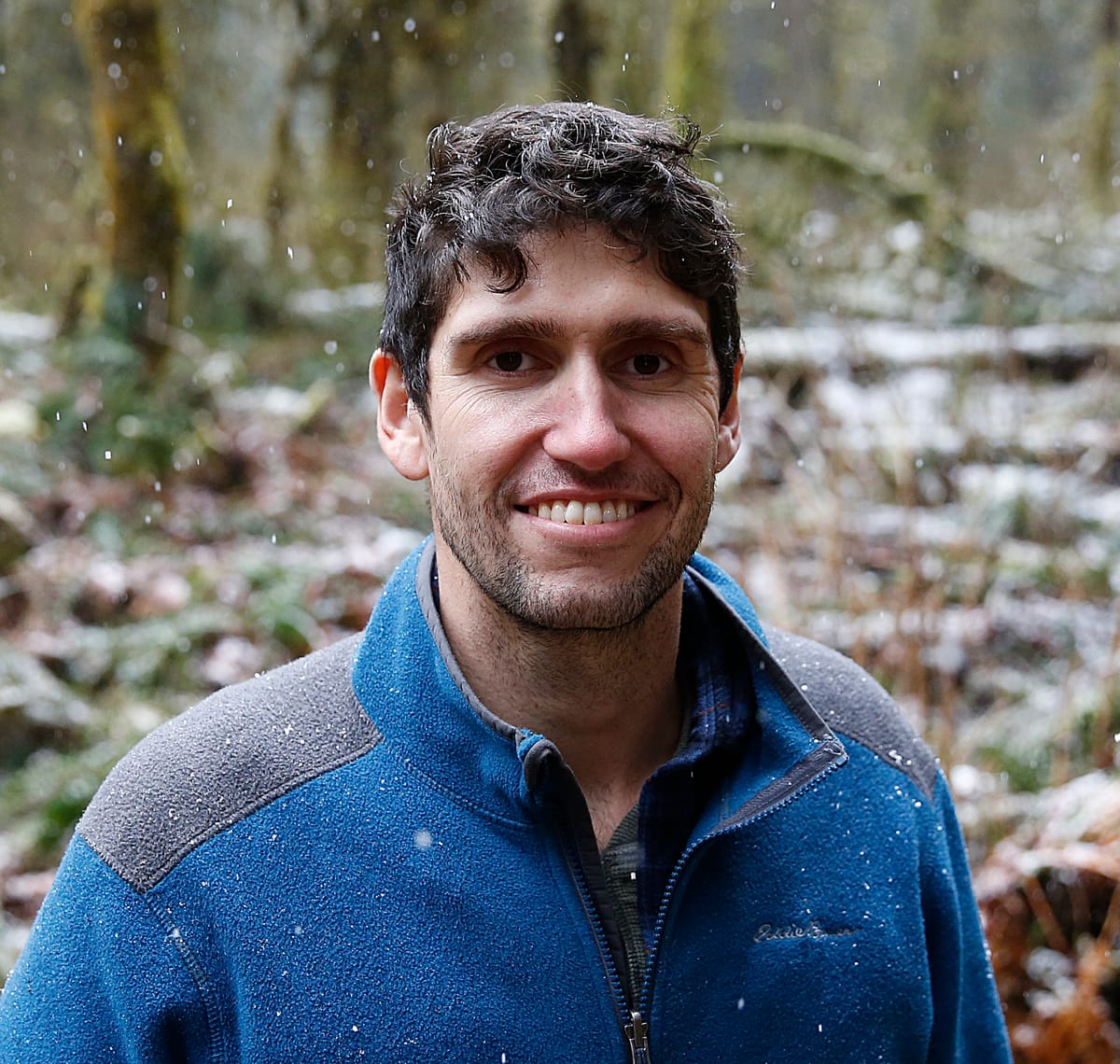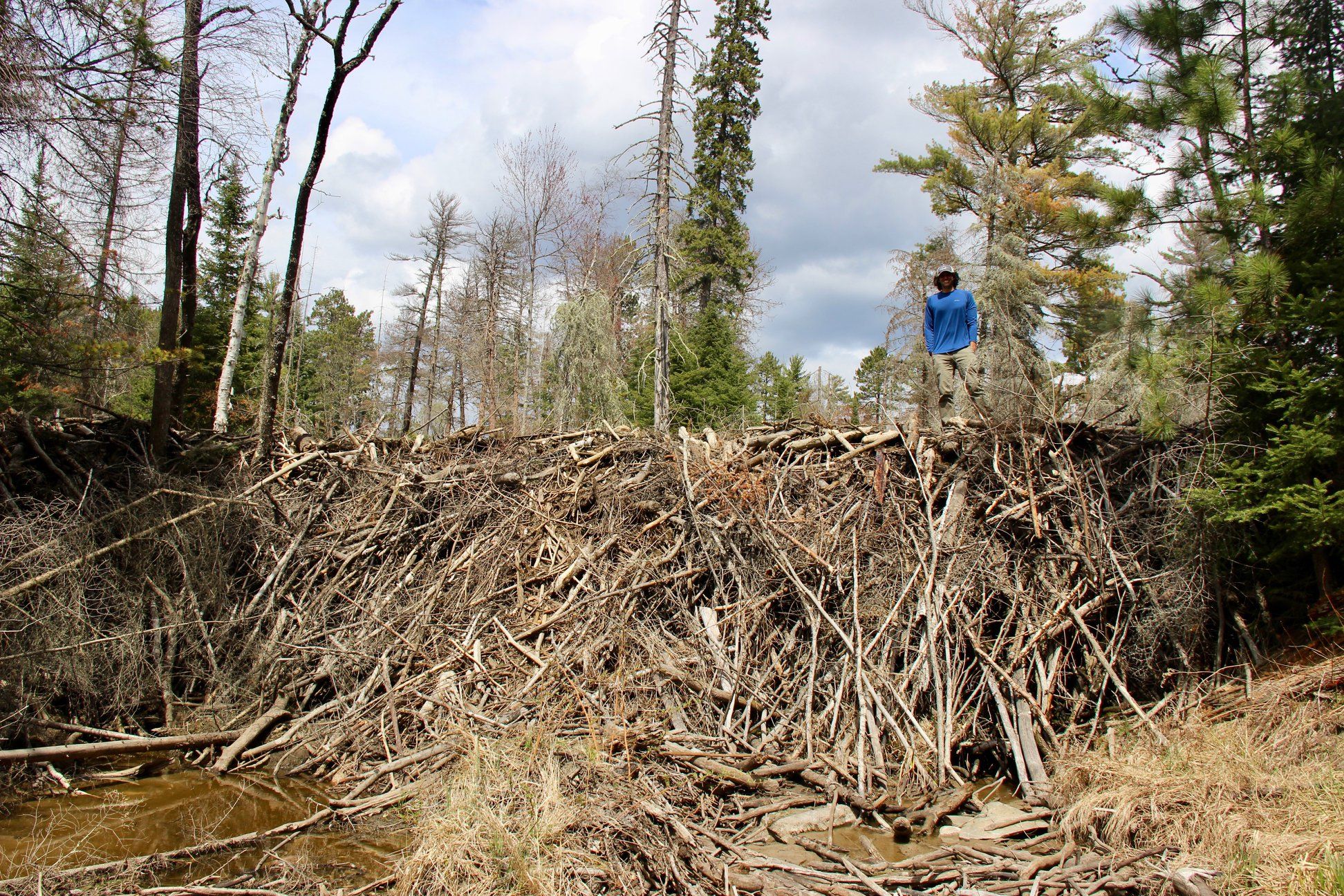A Beaver Believer: Into the World of Environmental Journalism — Alumni Profile, Benjamin Goldfarb ’09
Benjamin Goldfarb ’09 is an environmental journalist, award-winning author, and proud beaver fan. His work, published in a wide range of accredited magazines, focuses on wildlife conservation.

One lush spring evening, Benjamin Goldfarb ’09 and his parents, who were visiting him at Amherst, decided to take a walk along the rail trail. Suddenly, the three came across a group of beavers who had emerged from the wetlands. “[They] were just nibbling vegetation on the side of the bike path,” Goldfarb said. “We could almost reach down and pet them.” While he doesn’t attribute this exact moment to the beginning of his love for beavers, it became one of his most powerful early memories of the friendly critters. And now, as a successful environmental journalist and published author, Goldfarb has become quite the beaver aficionado.
The Hike to Amherst
Growing up in Hastings-on-Hudson, a village in Westchester County just north of New York City, Goldfarb’s childhood was filled with nature and the great outdoors. “I was fortunate to have parents who loved spending time outside, which I think really helped to inform my future and my career. They were creative, taking me and my brother to the Adirondacks and to the White Mountains in New Hampshire and to Nova Scotia,” Goldfarb said. “We went on lots of hiking and camping and fishing trips. That was a big part of how I grew up.”
In addition to falling in love with the town and the Pioneer Valley in general, Goldfarb was drawn to Amherst for the open curriculum and the opportunity to continue playing baseball at the college level. “I think the opportunity to make my own way as a student was really exciting,” Goldfarb said. “The lack of course requirements appealed to me as well.”
It was, in part, the flexibility of the open curriculum that allowed Goldfarb the opportunity to explore the breadth of Amherst’s course offerings — and also led him to create some of his own.
Bats, Snakes, and Wallabies
In addition to majoring in English at Amherst, Goldfarb was part of the first graduating class of students who majored in Environmental Studies.“I always loved to write and to read, and I sort of thought that that was just always what I was going to do. I took a lot of creative writing classes, mostly fiction, at Amherst,” Goldfarb said. “[My parents] were bookish people as well. I grew up in a house full of books, and we read constantly and often read while camping,” he added.
His desire to pursue Environmental Studies along with English was in large part due to the study abroad experience he had his junior year of college. “I did a study abroad program in Australia doing tropical field ecology, basically studying bats and snakes and wallabies,” said Goldfarb. “That was just an amazing experience, which really helped me remember that I love nature and care deeply about conservation and wildlife. So I came back to Amherst really fired up about environmental studies.”
At the time, there were only a few courses offered at Amherst that touched on topics relating to environmental studies. There was not a specific department devoted to the discipline.
“I definitely don’t want to overstate my role in any of this, you know, it’s not like I was meeting with the dean on a regular basis to make this happen,” Goldfarb said. “I was one of this small cohort of students who was passionate about [environmental studies] and wanted to pursue it.” He credits a lot of the success in the creation of the department to Charles Hamilton Houston Professor of American Culture, Emeritus Jan Dizard, who Goldfarb believes “had the vision for the program.”
Alongside pursuing environmental studies after studying abroad, Goldfarb wrote a senior thesis in creative writing in the form of a novella. He attributes a great deal of what he got out of the thesis process to his advisor at the time, visiting professor Alexander Chee. “He treated his advisees like peers and adults in a way that I think is somewhat rare for faculty members,” Goldfarb reflected. “And he made writing as a professional seem like an attainable career … I have a lot of gratitude to Alex for both making my work stronger but also making writing feel like an attainable career.”
Well before he was declaring majors, writing theses, and creating new departments, Goldfarb has fond memories of his early college days. During his freshman year, Goldfarb lived in a dormitory named Plaza, which was temporary student housing near the sports fields.
“When I was ranking my freshman housing preferences. I chose Plaza because it sounded grandiose. I didn’t know anything about it. And I was probably the only person who actually requested Plaza [because] it was a trailer,” he said. “I ended up loving living there. I loved the people I lived with — I think because we were somewhat isolated from ‘real freshman dorms,’ … we kind of banded together.” Goldfarb said he is ultimately grateful to have had the experience of living in Plaza, and the people he lived with became his lifelong friends.
Penning a Career
Through the friends he made and the classes he took, Goldfarb’s four years at Amherst shaped him as a person and prepared him to create a career where he could exercise all his passions. Upon graduation, he had a series of field ecology jobs, working for the National Park Service in Yellowstone and the New York City Parks department doing urban forestry research. Goldfarb didn’t stray too far from his interests in English either; he spent a year teaching English in Thailand. It was in Thailand where Goldfarb ended up meeting his future wife, another American working in Bangkok at the same school as he was.
In all of his lines of work, Goldfarb noted the persistence ofwriting in his life. “I was still writing the whole time,” Goldfarb said. “I was thinking a lot about blogging along the way, and I was really, really enjoying that blog and writing about the things that I was working on for a popular audience.”
Goldfarb ultimately decided to pursue higher education at the graduate level, receiving his Master’s in Environmental Management from the Yale School of Forestry. During graduate school, he began writing for campus magazines and freelancing pieces that had to do with topics he was learning about in class. “Over time, it just felt like maybe writing about nature and wildlife and ecology was the path for me … I care really deeply about wildlife conservation. And I love to write,” Goldfarb said. “It just eventually felt like if you can synthesize the thing that you care about with the thing that you enjoy doing on a daily basis, maybe that’s the recipe for a happy career.”
Articles, Books, and Beavers … oh my!
After graduate school, Goldfarb worked for High Country News, a magazine dedicated to environmental issues in the Western United States. At the time, Goldfarb was living in Seattle and working as the newspaper’s Northwest correspondent.
“As a journalist, you're always just looking for stories … and somebody sent me a flyer for a beaver workshop, and I was like, ‘I have no idea what a beaver workshop entails, but it sounds like that could be a story,’” he said. “I go to the workshop, just in a Seattle suburb. And it was quite literally life changing.” According to Goldfarb, the workshop consisted of scientists getting up to speak one at a time about the significance of beaver ponds and wetlands for storing water, decreasing pollution, and creating habitats for endangered species. As a result, Goldfarb ended up writing about beaver restoration for various publications, which eventually turned into the first book of his career.
In total, Goldfarb has now written three books — two for adults and one for children. His book on beavers, entitled “Eager,” explains the unsung role beavers play in the success of our ecosystem, and how increasing destruction of the creatures will prove to be a more detrimental loss than many people may realize. The book also focuses on a group of people who call themselves “Beaver Believers.” “[Beaver Believers] are very invested in helping these animals return, either by actively relocating them, or managing the land in ways that encourage their recovery, or just not killing them,” Goldfarb said. As a whole, the aim of the book is to grow national and global interest in the restoration of the beaver species.

Upon reflection, Goldfarb realized that the work he is doing now is not far from what he pursued at Amherst. In college, he recalls taking a biology seminar class taught by Professor of Biology and Environmental Studies Rachel Levin that influenced him greatly. “We would read papers about various issues in conservation — how do you manage invasive species, how do you reconnect fragmented habitats, and then we would just talk about them … now here I am, 15 years later, basically writing about those exact same issues,” Goldfarb said. “I don't think that’s a coincidence.”
For Amherst students, his biggest piece of career advice is to “figure out what it is that you’re passionate about. And then figure out what it is that you enjoy doing on a daily basis … and if you can combine your values and your passions with your aptitudes … that’s a good recipe.”
Acknowledging the cliché, he also urges current Amherst students to truly enjoy their time in college. “It's an amazing time in your life,” he said. “This is an opportunity to discover who you are and what you care about … this period of learning and self discovery could potentially form your life, so I would just say enjoy that process of self discovery because it’s a great gift.”
Goldfarb now lives in Colorado, and spends his free time hiking, fly-fishing, and cross country skiing with his wife and dog — who they appropriately call Kit, another name for a baby beaver.





Comments ()